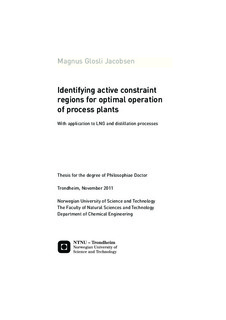| dc.contributor.author | Jacobsen, Magnus Glosli | nb_NO |
| dc.date.accessioned | 2014-12-19T13:23:30Z | |
| dc.date.available | 2014-12-19T13:23:30Z | |
| dc.date.created | 2012-01-10 | nb_NO |
| dc.date.issued | 2011 | nb_NO |
| dc.identifier | 475580 | nb_NO |
| dc.identifier.isbn | 978-82-471-3138-1 (printed ver.) | nb_NO |
| dc.identifier.isbn | 978-82-471-3139-8 (electronic ver.) | nb_NO |
| dc.identifier.uri | http://hdl.handle.net/11250/248266 | |
| dc.description.abstract | Optimal operation and control of chemical processes depends on external conditions or disturbances. In order to achieve optimal or near-optimal control,one wants to control the active constraints, and the active constraints will frequently change with disturbances.
Any remaining degrees of freedom can be used to control variables whose optimal values are relatively insensitive to disturbances, these are called self-optimizing variables. However, when disturbances cause the active constraintsto change, the best choice of self-optimizing variables will change as well. Thus it is important to have knowledge of how the set of active constraints changes with disturbances. This is particularly important when designing the control structure for a process.
The first chapter of the thesis deals with identifying active constraint regions, and describes a simple method for doing this in the case of two disturbances. This method is then later in the thesis applied on distillation case studies, and on a natural gas liquefaction process.
The second half of the thesis focuses on optimization and optimal operationof natural gas liquefaction plants. Liquefied natural gas (LNG) hasbeen an important product in the gas industry since the 1960s, but optimal operation of liquefaction plants has not gained much attention in the open literature until the last decade. The thesis aims to give an overview overearlier work in this area. It is found that most attempts at optimization ofsuch processes involves use of gradient-free optimization methods. A chapter of the thesis is dedicated to studying challenges in optimization, and serves to partly explain why this is the case. In particular, this chapter discusses the effect of model formulation on optimization performance.
Finally, the findings of the previous chapters are used to identify active constraint regions for the PRICO liquefaction process, which is much used in earlier academic case studies because of its simplicity. In this chapter, acontrol structure for the PRICO process is also suggested. | nb_NO |
| dc.language | eng | nb_NO |
| dc.publisher | Norges teknisk-naturvitenskapelige universitet, Fakultet for naturvitenskap og teknologi, Institutt for kjemisk prosessteknologi | nb_NO |
| dc.relation.ispartofseries | Doktoravhandlinger ved NTNU, 1503-8181; 2011:284 | nb_NO |
| dc.relation.haspart | Jacobsen, Magnus G.; Skogestad, Sigurd. Active Constraint Regions for Optimal Operation of Chemical Processes. Industrial & Engineering Chemistry Research. (ISSN 0888-5885). 50(19): 11226-11236, 2011. <a href='http://dx.doi.org/10.1021/ie2012196'>10.1021/ie2012196</a>. | nb_NO |
| dc.relation.haspart | Jacobsen, Magnus G; Skogestad, Sigurd. Active constraint regions for optimal operation of distillation columns. . | nb_NO |
| dc.relation.haspart | Jacobsen, Magnus G.; Skogestad, Sigurd. Optimization of LNG plants - challenges and strategies. 21ST EUROPEAN SYMPOSIUM ON COMPUTER AIDED PROCESS ENGINEERING: 1854-1858, 2011. | nb_NO |
| dc.relation.haspart | Jacobsen, Magnus G.; Skogestad, Sigurd. Active constraint regions for a simple LNG process. . | nb_NO |
| dc.title | Identifying active constraintregions for optimal operationof process plants: With application to LNG and distillation processes | nb_NO |
| dc.type | Doctoral thesis | nb_NO |
| dc.contributor.department | Norges teknisk-naturvitenskapelige universitet, Fakultet for naturvitenskap og teknologi, Institutt for kjemisk prosessteknologi | nb_NO |
| dc.description.degree | PhD i kjemisk prosessteknologi | nb_NO |
| dc.description.degree | PhD in Chemical Process Engineering | en_GB |
